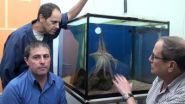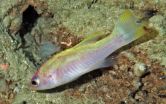(Press-News.org) Researchers at North Carolina State University have developed new modifications for technology that helps pilots of small aircraft avoid midair collisions. The modified tools significantly improved pilot response times in making decisions to avert crashes.
At issue are "cockpit displays of traffic information" (CDTIs). These are GPS displays used by private pilots to track other aircraft in their vicinity. However, pilots often focus on the closest aircraft on the display – a habit that can pose a significant hazard.
If the pilot of Plane A sees two planes on the CDTI, he's more likely to focus on the closest aircraft (Plane B). But if the more distant plane (Plane C) is moving at high speed, it could cross his path before Plane B does. Not paying enough attention to Plane C increases risk of a midair collision.
"Our goal was to modify a CDTI to help pilots recognize which other planes pose the greatest risk," says Carl Pankok, lead author of a study on the work and a Ph.D. student in the Edward P. Fitts Department of Industrial and Systems Engineering at NC State. "And it worked."
Researchers modified the CDTI so that the plane that would cross a pilot's path first either began blinking or was colored yellow.
The researchers tested the modified CDTI in a flight simulator with a panel of licensed recreational pilots. The research team compared the pilots' response times and decision-making accuracy when using the modified and unmodified displays.
"These pilots were already pretty good, but the modified CDTIs made them better," Pankok says. "Their percentage of 'correct' decisions – minimizing risk – jumped from 88 percent to 96 percent. And their response times in scenarios where the farther aircraft was the higher-risk aircraft were cut in half; from 7.2 seconds to 3.7 seconds for blinking CDTIs, and to 4 seconds for yellow CDTIs.
"We're not trying to make money off this," Pankok says. "We're hoping that CDTI manufacturers can incorporate these changes and possibly save lives."
INFORMATION:
The paper, "Cockpit Displays of Traffic Information and Pilot Bias in Time-to-Contact Judgments," is published in the June issue of Aviation, Space, and Environmental Medicine. Senior author of the paper is Dr. David Kaber, a professor in the Edward P. Fitts Department of Industrial and Systems Engineering at NC State. The work was supported by the U.S. National Institute for Occupational Safety and Health under grant No.2 T42 OH008673-08.
Engineers find way to lower risk of midair collisions for small aircraft
2014-05-19
ELSE PRESS RELEASES FROM THIS DATE:
How octopuses don't tie themselves in knots revealed by Hebrew University scientists
2014-05-19
An octopus's arms are covered in hundreds of suckers that will stick to just about anything, with one important exception: those suckers generally won't grab onto the octopus itself, otherwise the impressively flexible animals would quickly find themselves all tangled up.
Now, researchers from the Hebrew University of Jerusalem report that they discovered how octopuses manage this feat, even as the creatures' brains are unaware of what their arms are doing. A chemical produced by octopus skin temporarily prevents their suckers from sucking.
"We were surprised that ...
The spot-tail golden bass: A new fish species from deep reefs of the southern Caribbean
2014-05-19
Smithsonian scientists describe a colorful new species of small coral reef sea bass from depths of 182–241 m off Curaçao, southern Caribbean. With predominantly yellow body and fins, the new species, Liopropoma santi, closely resembles the other two "golden basses" found together with it at Curaçao: L. aberrans and L. olneyi.
The scientists originally thought there was a single species of golden bass on deep reefs off Curaçao, but DNA data, distinct color patterns, and morphology revealed three. The study describing one of those, L. santi—the deepest known species of ...
Neutron beams reveal how antibodies cluster in solution
2014-05-19
Scientists have used small-angle neutron scattering (SANS) and neutron spin-echo (NSE) techniques for the first time to understand how monoclonal antibodies (mAbs), a class of targeted biopharmaceuticals used to treat autoimmune disorders and cancer, dynamically cluster and move in high concentration solutions. Certain mAb cluster arrangements can thicken pharmaceutical solutions; they could thus limit the feasible concentration of injectables administered to patients around the world. The insights provided by a team of neutron scientists from the National Center of Neutron ...
San Diego county fires still rage
2014-05-19
The San Diego County fires that began on Wednesday May 14 as a single fire that erupted into nine fires that burned out of control for days. According to News Channel 8, the ABC affiliate in San Diego, the following summarizes what the current conditions are for the fires still left burning:
"Cocos Fire - San Marcos: This fire has burned 1,995 acres and is 87 percent contained Monday morning. All evacuation orders and road closures were lifted as of 11 a.m. Sunday, according to the City of San Marcos.
San Mateo Fire - Camp Pendleton: The San Mateo Fire that was reported ...
New technique to prevent anal sphincter lesions due to episiotomy during child delivery
2014-05-19
Results of a 10-year long multinational research project on Technologies for Anal Sphincter analysis and Incontinence (TASI) are available in:
Corrado Cescon, Diego Riva , Vita Začesta, Kristina Drusany-Starič, Konstantinos Martsidis,
Olexander Protsepko, Kaven Baessler, Roberto Merletti
Effect of vaginal delivery on the external anal sphincter muscle innervation pattern evaluated by multichannel surface EMG: results of the multicentre study TASI-2
International Urogynecology Journal, DOI 10.1007/s00192-014-2375-0.
Episiotomy is a controversial surgical ...
Studies published in NEJM identify promising drug therapies for fatal lung disease
2014-05-19
LOS ANGELES (May 18, 2014) – Researchers in separate clinical trials found two drugs slow the progression of idiopathic pulmonary fibrosis, a fatal lung disease with no effective treatment or cure, and for which there is currently no therapy approved by the Food and Drug Administration.
Paul W. Noble, MD, chair of the Department of Medicine at Cedars-Sinai and director of the Women's Guild Lung Institute, is the senior author of the multicenter study that found that the investigational drug pirfenidone significantly slowed the loss of lung function and reduced the ...
EPA ToxCast data validates BioMAP® systems' ability to predict drug, chemical toxicities
2014-05-19
FREMONT, CA (May 19, 2014): Newly published research demonstrates the ability of BioMAP® Systems, a unique set of primary human cell and co-culture assays that model human disease and pathway biology, to identify important safety aspects of drugs and chemicals more efficiently and accurately than can be achieved by animal testing. Data from BioMAP Systems analysis of 776 environmental chemicals, including reference pharmaceuticals and failed drugs, on their ability to disrupt physiologically important human biological pathways were published online this week in Nature ...
Fluoridating water does not lower IQ: New Zealand research
2014-05-19
New research out of New Zealand's world-renowned Dunedin Multidisciplinary Study does not support claims that fluoridating water adversely affects children's mental development and adult IQ.
The researchers were testing the contentious claim that exposure to levels of fluoride used in community water fluoridation is toxic to the developing brain and can cause IQ deficits. Their findings are newly published in the highly respected American Journal of Public Health.
The Dunedin Study has followed nearly all aspects of the health and development of around 1000 people born ...
Chinese scientists crack the genome of another diploid cotton Gossypium arboreum
2014-05-19
Shenzhen, May 18, 2014---Chinese scientists from Chinese Academy of Agricultural Sciences and BGI successfully deciphered the genome sequence of another diploid cotton-- Gossypium arboreum (AA) after the completed sequencing of G. raimondii (DD) in 2012. G. arboreum, a cultivated cotton, is a putative contributor for the A subgenome of cotton. Its completed genome will play a vital contribution to the future molecular breeding and genetic improvement of cotton and its close relatives. The latest study today was published online in Nature Genetics.
As one of the most ...
The young sperm, poised for greatness
2014-05-19
SALT LAKE CITY— In the body, a skin cell will always be skin, and a heart cell will always be heart. But in the first hours of life, cells in the nascent embryo become totipotent: they have the incredible flexibility to mature into skin, heart, gut, or any type of cell.
It was long assumed that the joining of egg and sperm launched a dramatic change in how and which genes were expressed. Instead, new research shows that totipotency is a step-wise process, manifesting as early as in precursors to sperm, called adult germline stem cells (AGSCs), which reside in the testes. ...




